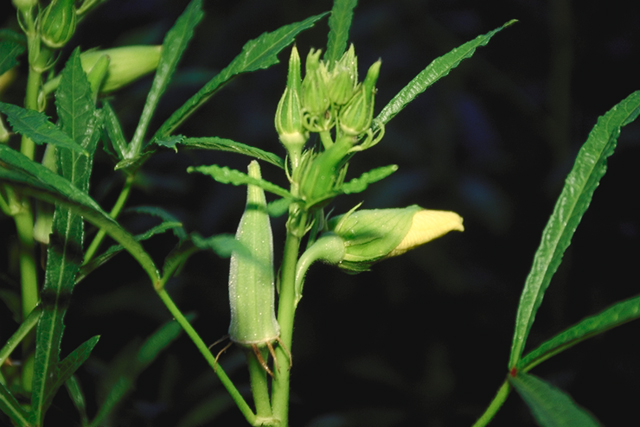- Abelmoschus
taxobox
name = "Abelmoschus"
image_caption = "Abelmoschus esculentus" leaves, flower buds and young fruit
regnum =Plantae
unranked_divisio =Angiosperms
unranked_classis =Eudicots
unranked_ordo =Rosids
ordo =Malvales
familia =Malvaceae
genus = "Abelmoschus"
genus_authority = Medik.
subdivision_ranks = Species
subdivision = See text.|"Abelmoschus" is a genus of about fifteen species of
flowering plant s in the mallow familyMalvaceae , native to tropicalAfrica ,Asia and northernAustralia . It was formerly included within "Hibiscus ", but is now classified as a distinct genus.The genus comprises annual and perennial
herbaceous plants, growing to 2 m tall. The leaves are 10-40 cm long and broad, palmately lobed with 3-7 lobes, the lobes very variable in depth, from barely lobed, to cut almost to the base of the leaf. Theflower s are 4-8 cm diameter, with five white to yellow petals, often with a red or purple spot at the base of each petal. Thefruit is a capsule, 5-20 cm long, containing numerousseed s."Abelmoschus" species are used as food plants by the
larva e of someLepidoptera species including "Chionodes hibiscella" which has been recorded on "A. moschatus".;Selected Species
*"Abelmoschus caillei " - (syn. "Hibsicus manihot" var. "caillei"). West African okra
*"Abelmoschus esculentus " - (syn. "Hibiscus esculentus").Okra
*"Abelmoschus manihot " - (syn. "Hibiscus manihot").Aibika
*"Abelmoschus moschatus " - (syn. "Hibiscus abelmoschus").Musk Mallow Uses
Several species are edible, with both the young seed pods and the young leaves being eaten as a
vegetable . The most important commercially-grown species isOkra ."Abelmoschus manihot" (aibika) furnishes cordage like
jute , and "Abelmoschus moschatus" (musk mallow) is grown formusk seed s (musk ambrette, which causesphotoallergy ).References
*Kundu BC, Biswas C. 1973. Anatomical characters for distinguishing the genera "Abelmoschus" and "Hibiscus". "Proc. Indian Sci. Congr." 60. (3): 295
Wikimedia Foundation. 2010.
